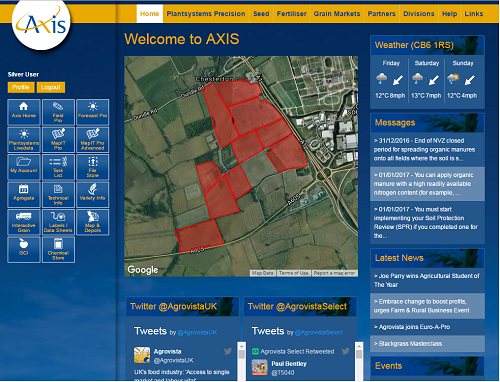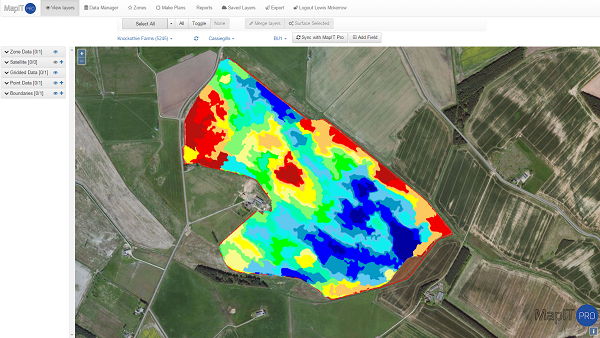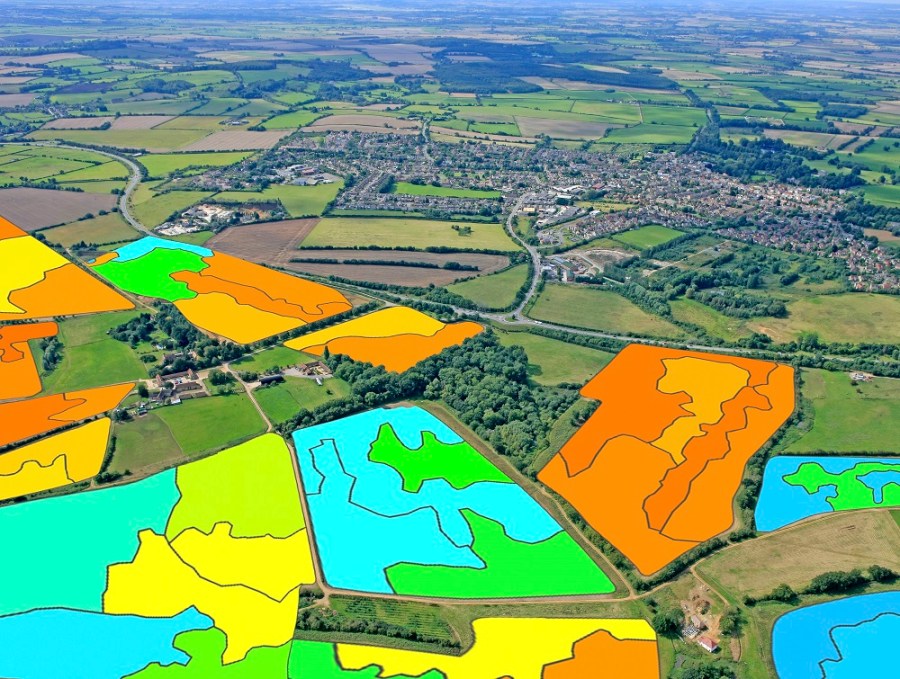True value from precision farming comes from having the right tools to capture the data, and the right platforms to help interpret results. In the first of a three-part series, in which CPM explores pioneers who have developed this space, we look at Agrovista’s Axis.
The user-friendly feel of Axis drives adoption in the field.
By Charlotte Cunningham
Love it or hate it, there’s no denying that technology has become a major influence on farming practices. Over the past few years, tight margins and the need for increased efficiency have led many growers to base management decisions on increasingly accurate data, from historical nutrient applications to targeted spray use with pinpoint precision.

Lewis McKerrow reckoned farmers would expect a web-based platform to deliver information, which is how Axis started.
With all this data being collected, farmers are wanting to make better use of the information available to them, without the hassle of sitting down every evening to hours of data inputting. The solution: Management software.
Agrovista identified this gap in the market at a regular strategy meeting in 2012, triggering a chain of events that would eventually lead to the birth of its web-based management platform, Axis: Agrovista eXchange Information System. “We held a blue sky thinking meeting looking at all possible options,” explains Lewis McKerrow, head of precision technology at Agrovista.
“We looked at our current customer base and what our customer of the future was likely to need, as well as what people liked and disliked about existing systems. We came to the decision that they would expect a web-based platform to deliver information – which is how Axis started.”

Axis is a technical information exchange system that allows agronomy and precision farming data to be uploaded and shared in real time.
So, what does it do? In a nutshell, Axis is a technical information exchange system that allows agronomy and precision farming data to be uploaded and shared in real time. It can be used as a free service to access Agrovista account information as well as variety, fertiliser, grain market and regulatory information. Alternatively, users can subscribe to one of four different modules for a more in-depth management platform. Subscription modules boast useful features such as gross margins and precision mapping, meaning users can manage any level of data, from soil to drone maps.

The software allows you to import data, such as this conductivity map.
Phase one of Axis focused on creating something that was bespoke to each customer, as well as building the information parts of the system. “To make it work, we had to gather a lot of information about varieties, seed and grain markets,” says Lewis McKerrow. “We benchmarked by looking at lots of different information from a variety of sources – such as AHDB – which allowed us to create the fundamental early demo system.”
Difficulties came when Agrovista began trying to utilise different systems and servers to enable features like mapping and forecasting. Axis was trying to do something totally new and some of the advanced mapping tools they created had never been done on a web-based system, explains Lewis McKerrow.
“There’s a limit to what browsers are capable of and there was an element of challenge in trying to make systems work seamlessly together and talk to each other,” he adds. “We had to go back to the drawing board and shrink down the vast amount of data we were using, and spent a lot of time working with developers.”
They finally cracked it in 2013 after developing a more precise mapping system that could work on the web – and it was around this time that the firm partnered with Muddy Boots software to help progress the system. “Agrovista has worked with Muddy Boots for a long time, utilising its expertise and software,” explains Lewis McKerrow. “When Axis started to develop, we worked very closely together to tailor our requirements and ensure a seamless flow of information.”
The partnership benefited both firms as Muddy Boots was already thinking about a web-based platform as the next generation of software, explains Muddy Boots’ Jeff Goulding. “The engine room of Axis is our Greenlight Grower Management system that was developed about five years ago – designed to capture, share and manage data,” he adds. “What impressed us about Agrovista was its innovative approach to engage with farmers and improve service-level delivery.”
As cropping plans can change very quickly, Axis allows changes to be made and passed between users at the click of a button. “The user-friendly feel of Axis drives adoption in the field, meaning users are easily able to capture and record data via a phone or app,” says Jeff Goulding. “In turn, this provides both farmers and associated professionals with higher quality information, which drives higher performance and better decision making.”
Though Lewis McKerrow always believed Axis would be a success, 2015 was the moment he felt the platform might just be a market leader in innovation. “We never doubted Axis, but all the way through, you do wonder – will it work? Are people going to use it? You can do as much research as you like but you can never be quite sure.”
Fast forward to June 2015 – the official launch at the Cereals event. “The initial reaction was positive, but there were a number of key features that were undeveloped,” explains Lewis McKerrow. “Farmers were hungry for more functionality.”
Over the past 12 months, the firm has developed additional features including field and fertiliser recording – which were only in the early stages last year.
Today, Axis boasts around 1500 customers, growing rapidly as more functionality is added to the platform. “Farmers can really benefit from the subscription modules,” says Lewis McKerrow. “Axis Field Pro is great for record keeping, covering elements like cropping, inputs and costs, allowing users to begin to build up gross margins for the farm,” he explains.
“The Axis MapIT Pro option focuses more on precision farming and uses a Google-based mapping system to manage any level of data – including soil and drone maps – and can also be synchronised with machinery.”
So, how do farmers feel about it? The use of technology is becoming increasingly important as margins are squeezed, farms get bigger and machinery gets more complicated. However, there needs to be a visible benefit to attract usage, says Jeff Goulding. “The overall message we’ve received is that if technology adds value, farmers are interested. They’re reluctant to spend and invest unless there’s something tangible to be gained – there has to be a real benefit.”
One producer who’s using Axis on his farm is mixed beef and arable farmer, Alistair Kingan. Farming 486ha in south west Scotland, Alistair Kingan has found Axis to be an extremely useful tool for managing a busy mix of enterprises in one place.
“We began looking into the software last year, but this is our first full season using Axis,” he says. “I now manage the whole farm from my phone and for me this was very important – it massively reduces the amount of paperwork in the office.”
Using Axis predominantly for costings, as well as keeping a record of data sheets, such as cross compliance information, Alistair Kingan found his workload has reduced significantly, maximising efficiency on farm. “I also run a contracting business and it’s great for time saving,” he explains.
“Before we started using Axis, there would often be occasions where chemicals would be delivered and I’d forget to print the spray sheet off to give to the operator, or the agronomist hadn’t sent them over, meaning I’d have to make an unnecessary trip back to get it. Now, everything is in one place – it certainly speeds things up; my spray operator loves it.”
As well as condensing information in one place, the platform is very easy to use, says Alistair Kingan. “It’s fool-proof,” he explains. “I’m using it for general management through the growing season and it’s very easy and straightforward – everything is just there.”
It’s not just farmers who are benefiting from the Axis system. Soil testing and liming company, S & S Agricultural Liming, have recently turned to Axis in a novel way. The firm specialises in pH and soil testing and is using the MapITPro module to create lime variable-shape files for use by its tractors and lime spreaders. “As a company, we were always looking for software that allowed us to carry out pH mapping,” explains Lace Twigg at S & S Agricultural Liming. “We’re really happy with it and it’s a nice, easy, simple system to use.”
The company uses the tools on both MapITPro and MapITPro Advance to create a farm map, draw on boundaries and mark the pH level at various test points as the advisors are walking through the field. The data is then synchronised and sent back to the computer, creating a pH map – detailing different zones and the rate of lime needed for each zone. This can then be saved and downloaded as a shape file and used in sync with the kit spreading the lime, says Lace Twigg.
“It’s the way forward for us,” she adds. “The real turning point for us was when we tested the shape files on our tractors and it worked. It reduces the time spent in the office and improves the accuracy of what we’re doing – everything is just more concise.”
Agronomists love it too. Steven Gate, an agronomist at Agrovista, has been involved with Axis since its conception and began using it on farm 18 months ago. “I mainly use the field icon – all of my recommendations go on that, meaning farmers have the information at their fingertips,” he explains. “MapIT Pro is also very useful for measuring fields; particularly if the fields are new or split, they can be easily mapped – I get a lot out of it.”
The remote access also helps to reduce workload and improve accuracy for agronomists, which is equally beneficial to farmers, says Steven Gate. “Farmers are very much on board,” he explains. “The fact it encompasses a lot of farm data in one place – whether it’s from the agronomist, the spray operator or the farmer himself – is key. The exchange of information is crucial.”
This exchange of information makes for much more accurate decision making and provides the tools to assist with big decisions, says Steven Gate. “Axis allows for much more interaction and helps both farmers and agronomists look at the full picture and take into account historic farm records.”
Interestingly, the younger generation appears to be the most excited about the upcoming technology available to them. “There seems to be a buzz within the youth in the farming community to take on this technology,” says Steven Gate.
Often, it’s the fear of the unknown that makes the older generation somewhat hesitant to embrace technological developments. However, the simplicity of the Axis system is one of its strongest points, he explains. “The icons are very user friendly and navigation is extremely straightforward. We’re no longer in an age of working with a box full of diaries, everything has moved online, and this is a very simple system.”
Of course, the innovation doesn’t end there and technology is evolving on a daily basis, so what is in the pipeline for Axis? Over the coming years it’ll see a redesign to give it a new fresh feel, and will become more mobile friendly through optimised browser technology. “We’ll also be looking at how we integrate drone technology,” says Lewis McKerrow. “At the moment, we send out a link to users to access the data from drones, but this change will put all the data on one platform.
“Axis is great tool for improving efficiencies on farm and helps to fast track knowledge of the land,” he adds. “It’s important that everyone is making use of data – this platform enables all users to form closer relationships between all the data that’s available to them.”
Innovation Insight
CPM would like to thank Agrovista for kindly sponsoring this article, and for providing privileged access to staff and material used to help put the article together.




